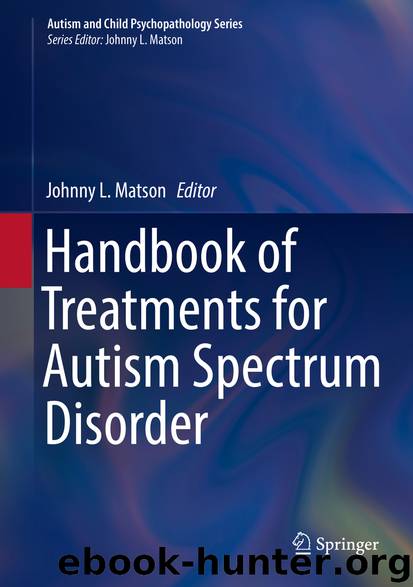Handbook of Treatments for Autism Spectrum Disorder by Johnny L. Matson

Author:Johnny L. Matson
Language: eng
Format: epub
Publisher: Springer International Publishing, Cham
Video modeling interventions may be divided into three primary subtypes: video modeling of others, point-of-view video modeling, and video self-modeling. Video modeling of others describes the process of allowing an individual to watch known or unknown peers, or adults demonstrate the target behavior without error (e.g., McCoy & Hermansen, 2007). Videos are filmed from a third-person point of view. Although social learning theory describes models as more effective when they are similar to an observer (e.g., Bandura, 1977), researchers have often used individuals of different ages and genders with positive results (e.g., Mason et al., 2013). Video models of others are typically easier to create than other forms of video models as they require less editing and less prompting (Ganz, Earles-Vollrath, & Cook, 2011). An example of video modeling of others is found in O’Handley, Radley, and Whipple (2015), who utilized a video model of two adults engaged in conversation to promote eye contact of high school-age individuals with ASD. Following implementation of the video modeling of other interventions, rapid improvements in the duration of eye contact during conversations in both training and generalization settings were observed.
Point-of-view video modeling differs from video modeling of adults or peers in that the videos are filmed from a first-person perspective. As such, the individual demonstrating the target skill is not directly observed. Instead, the video depicts performance of the target social skill as if the individual were engaged in the skill (McCoy & Hermansen, 2007). Some have suggested that point-of-view modeling may be more effective than other types of video modeling as videos from a first-person perspective may be better able to highlight relevant stimuli (Tetreault & Lerman, 2010). Despite the potential benefits of point-of-view video modeling, the modality is less relatively less researched than other forms of video modeling (Lee, 2015). In the few examples of point-of-view modeling to teach social skills, results have demonstrated improvements in skills such as functional play (Scheflen, Freeman, & Paparella, 2012) and eye contact (Tetreault & Lerman, 2010).
The final subtype of video modeling, video self-modeling, describes the process of watching oneself engaging in the target social skill. Video self-modeling may further be divided into two subtypes: positive self-review and feedforward (Hitchcock, Dowrick, & Prater, 2003). Positive self-review describes video recording intact, uncoached examples of target behaviors. In order to utilize positive self-review, an individual must have the target skill in their repertoire. Feedforward is a type of video modeling in which video segments of coached behaviors are edited together to produce an example of the desired social skill. The final video appears to show the individual performing the target skill flawlessly. For example, Bellini, Akullian, and Hopf (2007) utilized a feedforward procedure to increase social engagement of young children with ASD by prompting participants to interact and then editing recordings to remove facilitator-delivered prompts. Although not exclusive to research in social skills training for individuals with ASD, meta-analyses have found both subtypes of video self-modeling to be similarly effective (Mason et al., 2013).
Although several types of
Download
This site does not store any files on its server. We only index and link to content provided by other sites. Please contact the content providers to delete copyright contents if any and email us, we'll remove relevant links or contents immediately.
I Capture the Castle by Dodie Smith(1929)
Aspergirls by Rudy Simone(1601)
Be Different by John Elder Robison(1568)
Autism's False Prophets by Paul A. Offit(1461)
My Child's Different by Elaine Halligan(1439)
Smart but Scattered—and Stalled by Richard Guare(1424)
101 Tips for the Parents of Boys with Autism by Ken Siri(1396)
What's Making Our Children Sick? by Michelle Perro(1361)
Asperger Syndrome (Autism Spectrum Disorder) and Long-Term Relationships by Ashley Stanford(1346)
ADHD by Mark Selikowitz(1321)
Girlish by Lara Lillibridge(1313)
Nerdy, Shy, and Socially Inappropriate by Cynthia Kim(1285)
An Adult with an Autism Diagnosis by Gillan Drew(1277)
On Immunity: An Inoculation by Biss Eula(1260)
Animal-assisted Interventions for Individuals with Autism by Temple Grandin(1236)
Sarah's Child (Hqn Romance) by Linda Howard(1231)
Seeing Ezra by Kerry Cohen(1208)
The Cities by K.A Knight(1197)
Why Gender Matters by Leonard Sax M.D. Ph.D(1191)
